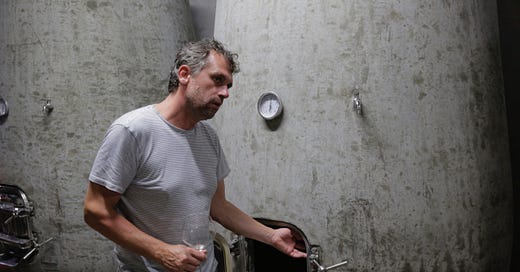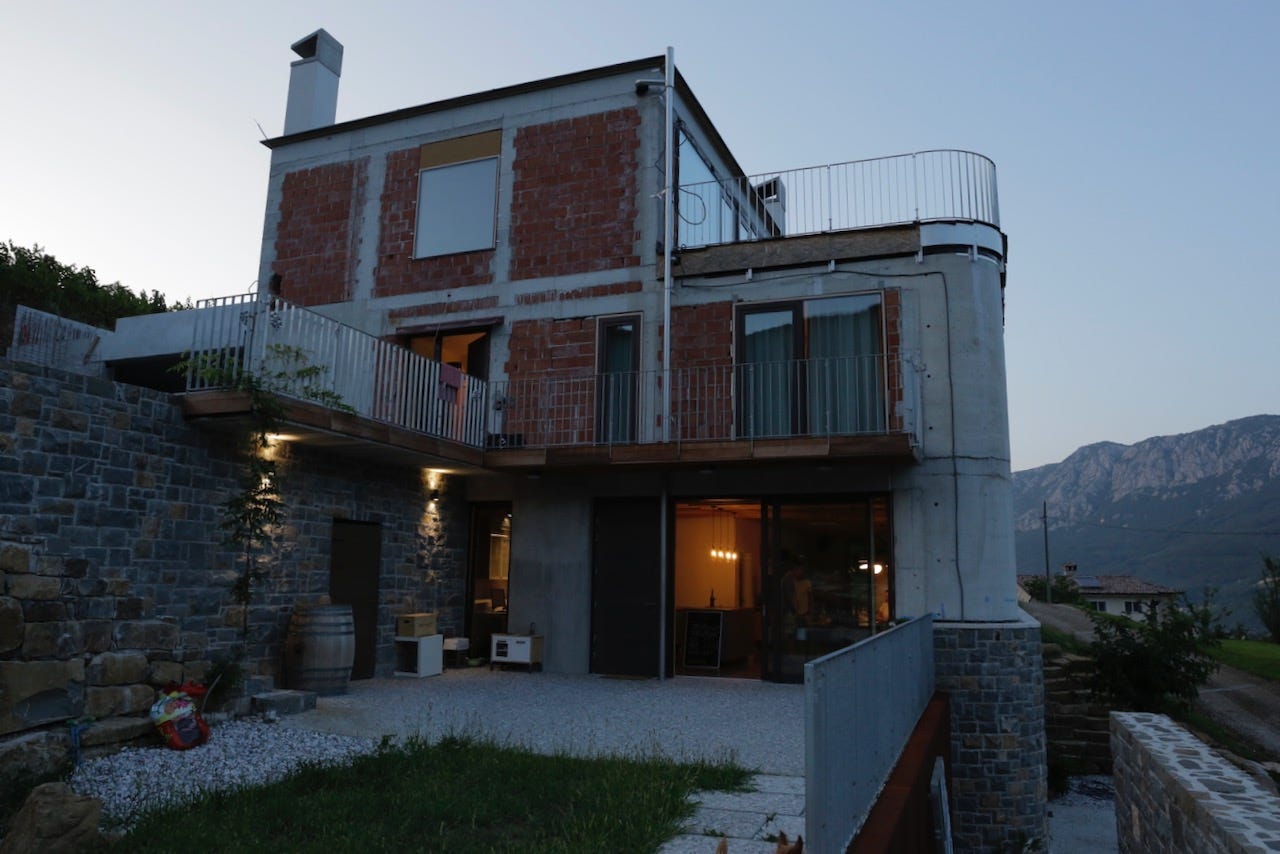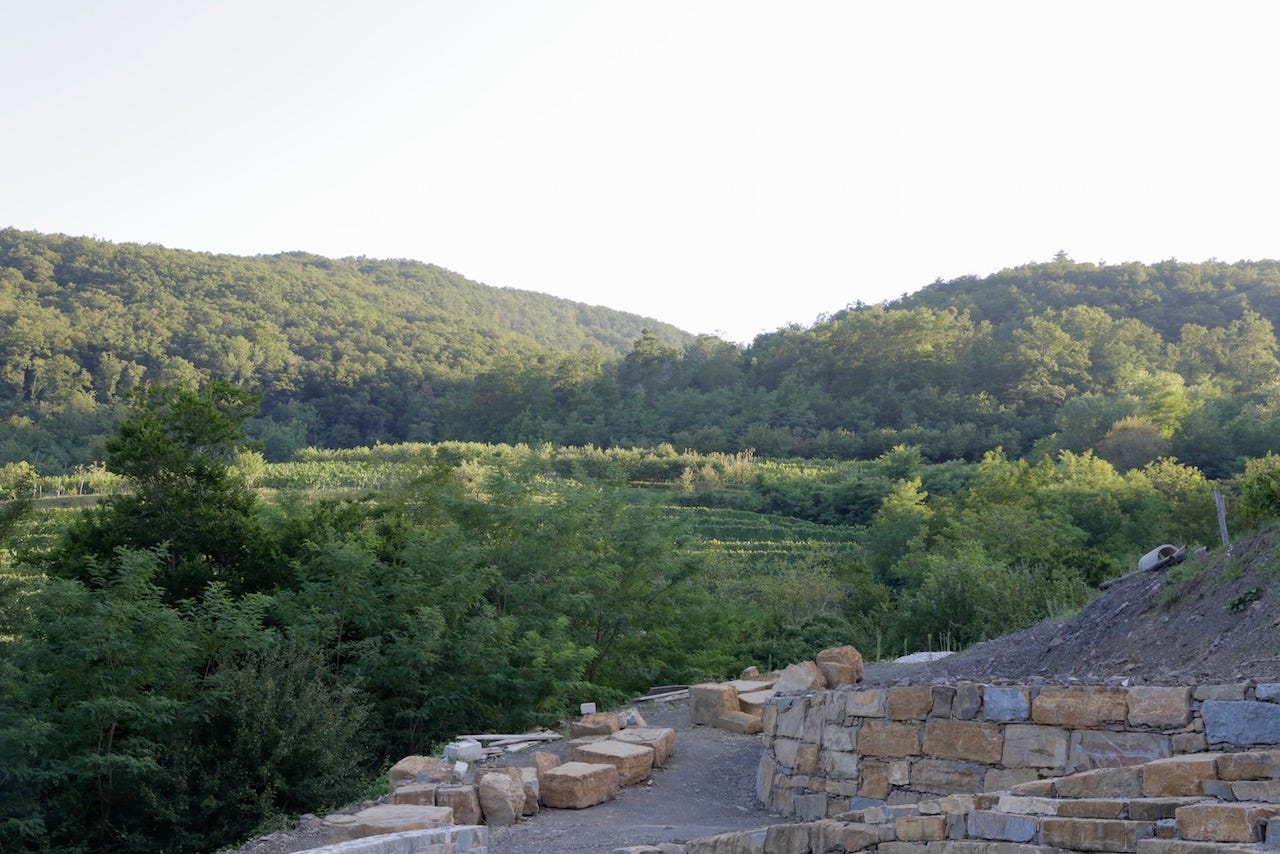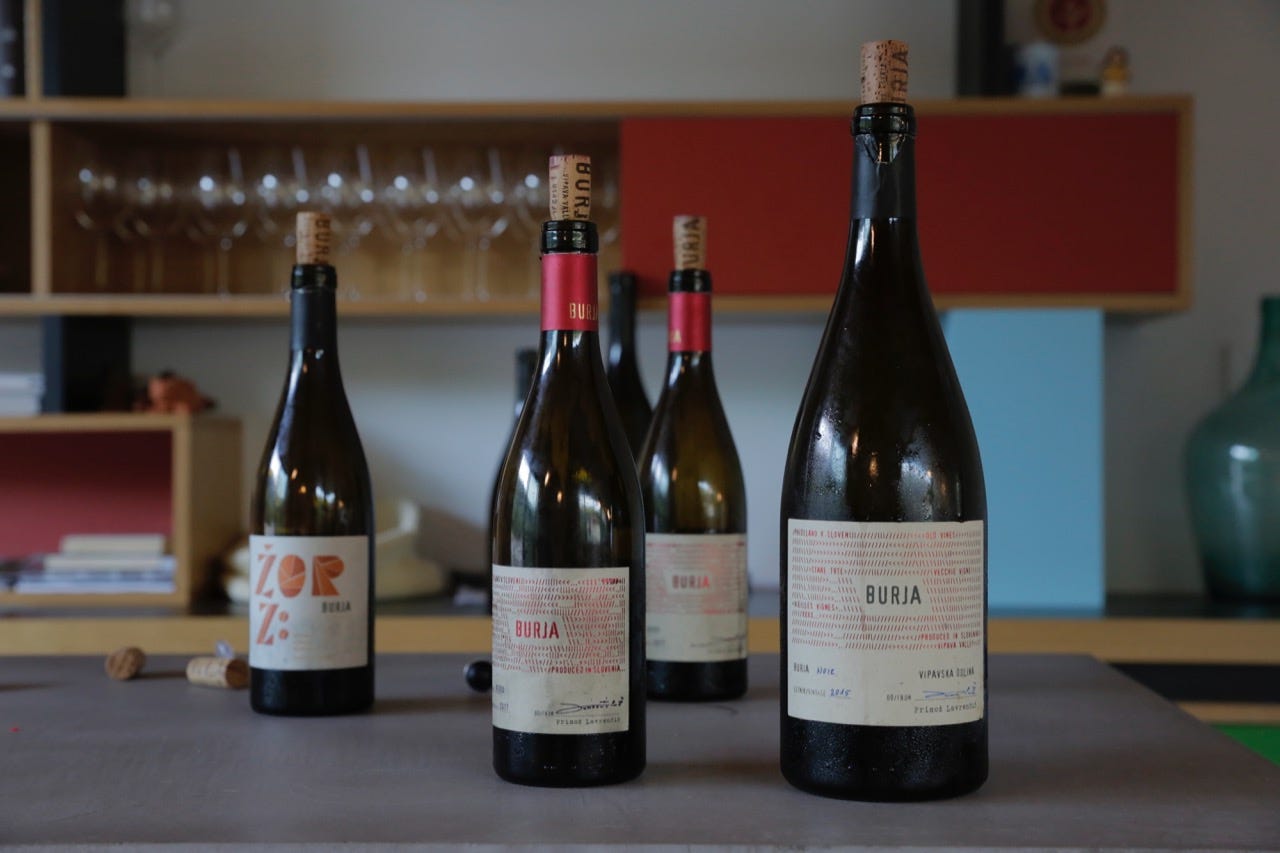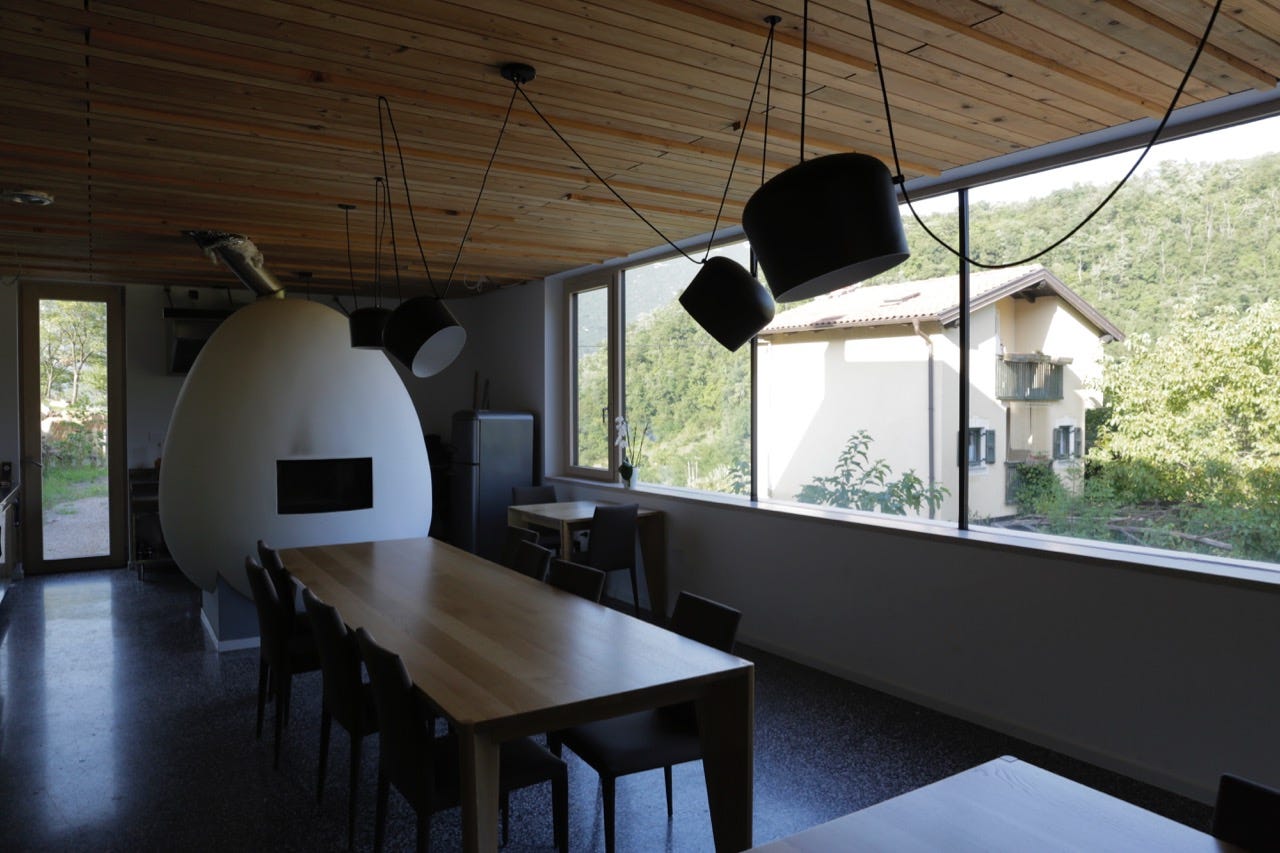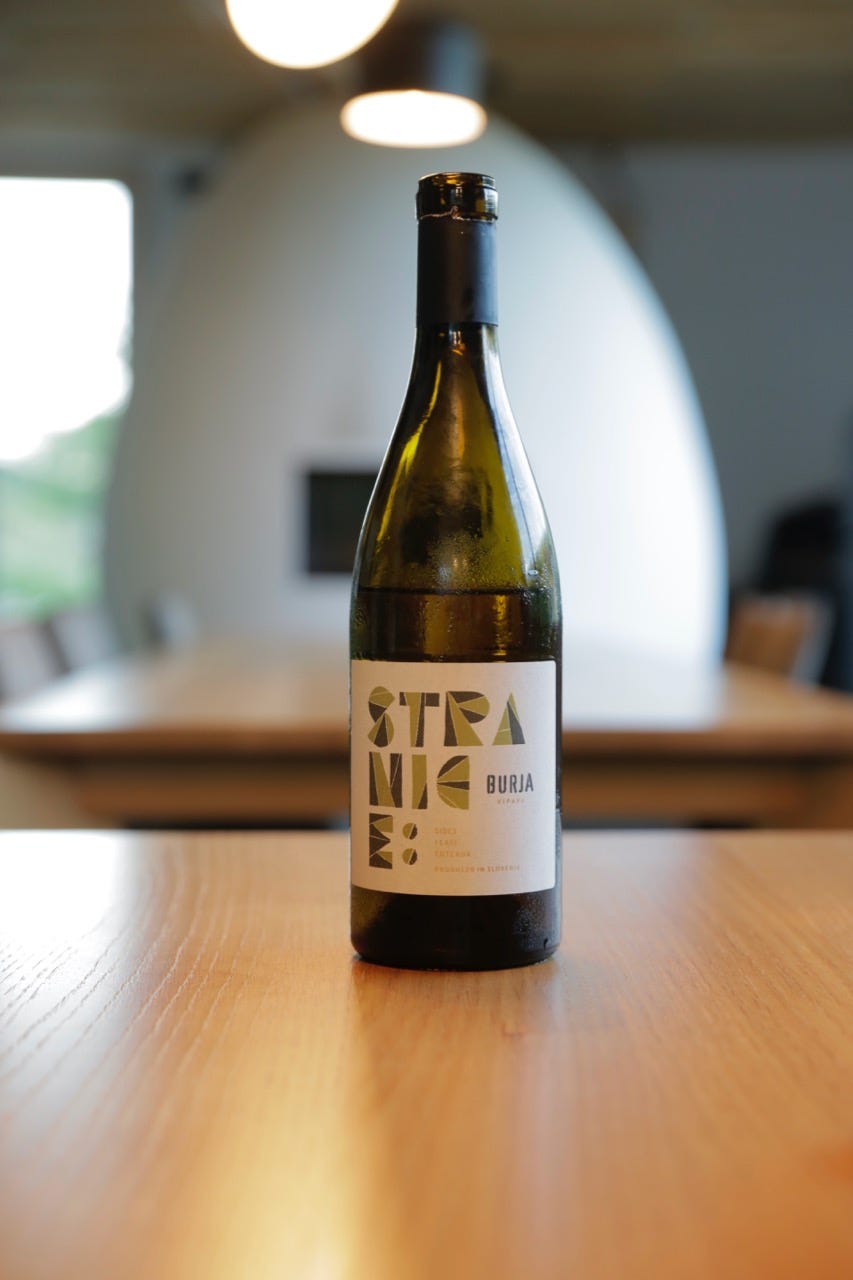SLOVENIA - Burja Estate, Podnanos
Primož Lavrenčič is building a masterpiece of a cellar, befitting his masterful Vipava valley wines.
Primož Lavrenčič - the wry, tousle-haired vigneron behind Slovenia's Burja Estate, in the Vipava valley - shows off his cellar with a matter-of-factness that belies its long gestation. With a wave he gestures to the site's painstaking vertical construction, carved into rock of the hillside, which includes a 5-ton elevator build for tanks and demi-muids, allowing him to produce wine almost entirely without pumps.
Since separating, in 2008, from his family's Sutor estate, Lavrenčič earned a reputation for his masterfully balanced, unfiltered, low-sulfur work with indigenous varieties, despite working from a rented cellar space in Vipava. He moved into his own cellar when it was still under construction in 2016. Now that it's almost complete, he appears visibly relieved to work at last in conditions of his own devising.
"Maybe I would never start all this again," he says, gesturing to the surrounding facility. "But now I’m happy I started it."
Lavrenčič speaks with a rapid-fire, slightly laconic technical precision, honed in time spent as an agronomy consultant during his departure from his family's estate. He says his conversion to additive-free winemaking was a slow, steady one, beginning with an aversion to the recommendations of his family's erstwhile winemaking consultant.
"I was immediately against eighty percent of it," he says. "For another eight years, until 2000, I still did a bit of filtration and sulfites, and even select yeasts. And then I was more and more interested in the real expression, when you leave the wine to do what it does."
I meet Lavrenčič at the destination of an August road-trip from Toulouse to Vipava, where a journalist friend called Barbara Repovs had arranged an itinerary of winery visits. Less renowned than its Italian-border sibling district of Brda, Vipava is an intensely windy, high-rainfall district about thirty minutes' drive further inland. The eponymous village is known for its numerous mountain springs within the city center; its houses are built with a special slot bordering the doorways, in which to insert sheathes to seal the thresholds in times of flood.
Lavrenčič's Burja Estate, in the nearby village of Podnanos, is named for the powerful winds that periodically blanket the area, and which are responsible for another of its architectural curiosities: roof tiles, on most houses, are held down with stones the size of aubergines.
As striking as any of Vipava's climatic distinctions is the ambition of its premier natural winemakers. Like his friend and colleague Zmago Petrič of Guerila Wines (on whom more later), Primož Lavrenčič is producing a nuanced, thoughtful range of distinctive natural wines from a spiffing cellar that would be the envy of vignerons the world over.
The local terroir - and its surprising humidity - is visible in the walls of the cellar. It is layers of the local marl called lapor (flysch) threaded with sandstone.
Lavrenčič farms just under 8ha. With the exception of some pinot noir vines he planted two decades ago, a memento of his winemaking internships in Burgundy, Lavrenčič's production emphasises native and local grape varieties: schioppettino, refosco, and blaufränkisch for reds, and zelen, malvasia, welschriesling, and rebula for whites.
"We were lucky because my father didn’t use any herbicides, not even any insecticides, except maybe twice in the last fifty years," explains Lavrenčič, whose vineyards were mostly acquired from his family's estate. "But we fertilised. That’s the only thing my father did that was a bit wrong."
Today Burja Estate has been organic-certified for over a decade, and recently obtained biodynamic certification as well.
"I'm learning from Zmago [Petrič]," Lavrenčič says. "I joke that Zmago is copying me with the traditional way of maceration and using old varieties, and I am copying him about biodynamics. He started two or three years before me."
Green harvesting - a practice I found to be surprisingly prevalent in Slovenia, at least with regards to France, where I don't often encounter it - is comparatively minimal at Burja, limited to around 20%. Lavrenčič says that since his father began the practice in the 1990's, the vines have adapted, and seem to produce less bunches by themselves nowadays.
Lavrenčič's vinification is distinguished by the aforementioned vertically constructed cellar, and his use of concrete vats, both egg-shaped and tulip-shaped, which he first installed in 2013.
After destemming, whites macerate in steel tanks and concrete vat, reds in concrete vat and wood vat. Lavrenčič aims to keep maceration temperatures between 18°-24°, occasionally employing a fridge for harvest if it comes in too hot.
"The reds we macerate until the fermentation is finished, and we macerate whites until the cap rises," he says. "This is my rule: I do whites until the cap is really constructed and I do reds until the cap falls."
The press is gravity-fed, after which point the juice flows to vinification tanks, mainly cement for whites, mainly demi-muid for reds. Vinification is additive-free, with the exception of a light sulfitage for most wines after final racking. (Total sulfur levels at final analyses are generally between 30-45mg/L.)
We taste several wines from barrel and tank, before repairing upstairs to taste bottled wines a work-in-progress tasting room dominated by a giant egg-shaped pizza oven.
The Burja Estate wines are a parade of masterful highlights. Lavrenčič's passion for pinot noir shines in a shimmeringly floral 2018 tank sample (recently reassembled from demi muids), one of the most graceful pinots I've tasted anywhere outside of Burgundy itself. A demi-muid of his 2018 "Burja Reddo," a muscular blend of schioppettino, refosco, and blaufränkisch, possesses the pedigreed force of a fine Cornas.
"After the Second World War, the politicians forced winemakers to plant a lot more red varieties than existed historically in the region. Just merlot and cabernet," explains Lavrenčič. "Historically it was about 90 percent white and 10 percent red."
It is in Lavrenčič's whites that one senses him taking a position on the identity - and the potential - of native Vipava white winemaking. In this district, the regional heavyweights of malvasia and rebula are complemented with the more local pinela and zelen grapes, both lighter, brighter varieties. Visiting Vipava, one surmises that one shouldn't necessarily expect the extractive powerhouse orange wines that have made Collio and Brda famous. Things tend slenderer, more fluid here. (Through a completely unscientific poll of one erudite eighty-year-old man in the town of Vipava, I learned that white wines in the 1940's and 1950's here were un-macerated, and often varietal blends.)
Lavrenčič himself conducts macerations of 7-12 days on his whites, in closed steel tanks, with minimal air contact. They are the sort of macerated whites that lead to quibbling about what is "orange wine" and what is not. (For my part, I still find it a useful phrase, even when applied to lightly-macerated whites, for the simple reason that "lightly-macerated whites" doesn't roll off the tongue in the same way.) He is a proponent of the local zelen - a faintly waxy, aromatic native grape that almost went extinct in the 1980's - vinified in a lighter, shorter-élévage style than his other whites. The flagship white cuvée is the "Burja Bela," a suave, pear-toned blend of malvasia, welschriesling, and rebula. His cuvée "Straniče," the same grape blend but from older, lower-yielding vines, is vivid and saline, having lost none of its pep throughout its longer concrete élévage.
Throughout Lavrenčič's oeuvre one perceives the poise and serene energy that come from healthy, minimally-manipulated (gravity-fed) juice. It's a hazy notion, not easy to articulate, perhaps related to entrapped CO2 and the distribution of particles and phenolic compounds throughout a wine. But it's something I increasingly seek when I drink and I was delighted to encounter it in Vipava.
Burja Estate - Primož Lavrenčič
Orehovica 46 5272 PODNANOS
Slovenia
Tel: +386 70 900 075
FURTHER READING
A very concise 2017 video of Lavrenčič at the Real Wine Fair, by Bottled Films.
Detailed tasting notes from a 2018 visit to Burja Estate at Piran Café, a site that resembles a content farm, but thankfully isn't.
A 2014 profile of Burja estate at Autochthoinos, a site which looks vaguely as though it was set up by some sort of tourism entity to resemble a blog. I may just be paranoid this morning.
A lengthy 2015 review of the 2010 "Burja Bela" at The Morning Claret.
A 2015 profile of Burja Estate at Slovenia Business Channel, a French-language site which appears to be a concerted attempt to entice French migration to Slovenia. Its "FAQ" page consists of a quick run-down of Slovenian labour law, as well as a short explanation of what a "FAQ" page is. (My advice to anyone starting a French-language website would be to give it a French-language name, and to avoid English acronyms.)

